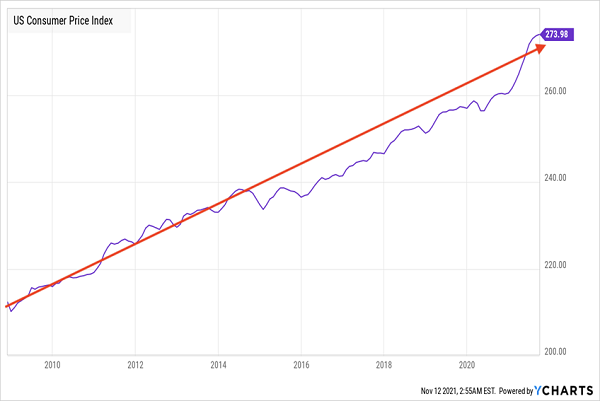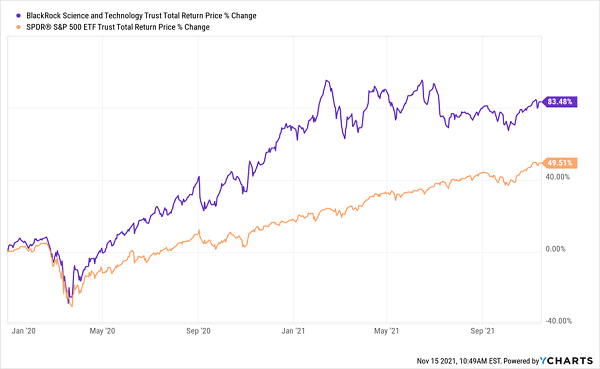It's a good idea to buy the dips when inflation numbers come out, suggests closed-end fund specialist Michael Foster, editor of CEF Insider.
Every time investors freak out about inflation and sell, the panic lasts a few days (or, in September, a few weeks) then stocks revert to their bullish trend.
That's no surprise; consumers are spending more, workers are earning more, and there's generally more economic activity. These are all pushing companies' revenue and profits higher, making each dip a buying opportunity.
It's also important to remember that these inflation reports compare this year's consumer prices to those from 2020, when we were mired in the worst pandemic in a century and an unprecedented economic shutdown. As the economy continues to rebound, it's not surprising that we would overshoot in the short term. This is actually good news.
What's more, if we take the long view and look at how inflation has trended since the end of the Great Recession, we see that the inflation-benchmark consumer price index (CPI) is above the trendline now (after being below it due to the interest-rate hikes of the mid-2010s), it's not ahead by much.

In other words, while inflation is high compared to 2020, it's close to reverting to the long-term trend. Plus, inflation is only really high if we compare it to the "lost year" of 2020; if we compare it to 2019, inflation is a more modest 3.3%.
So where does that leave us? With an optimistic storyline: while there we are hitting speed bumps, such as supply-chain issues and labor shortages, we're getting closer to what life was like in 2019 than what it was like in, say, 2008 or 1929 or 2020. In other words, it's a good time to keep investing in CEFs with payouts that are far higher than inflation — no matter if you calculate today's gains in the CPI based on 2020 or 2019!
A good play here involves two CEFs: one to buffer us (and pay a healthy 6.4% dividend) if inflation proves sticky, and one to set us up for gains (and a growing 5.4% payout) if inflation dies down in 2022, as the Fed expects. How you'd apportion funds to each CEF depends on your view of where prices (and rates) are headed.
First up, when inflation hits, we want to own "hard" assets that provide us with a high, safe income stream, like the utility stocks held by the Cohen & Steers Infrastructure Fund (UTF).
Standouts in UTF's portfolio are natural gas provider Enbridge Inc. (ENB), which benefits from higher energy demand and prices, as well as NextEra Energy (NEE), a green energy-focused utility that will profit from the Biden Administration's investments in renewable power and electrical infrastructure more generally.
If inflation rises sharply in 2022, UTF could easily outperform the market as investors go on the hunt for hedges — as well as an income stream that outruns rising prices.
If inflation flattens, we'd still collect UTF's high income stream while we look to our second fund for gains. That would be the tech-focused BlackRock Science and Technology Trust (BST), which hiked its dividend by more than 10% in October, its third hike since the pandemic hit.

In addition to higher payouts, this 5.5% yielder has been crushing the market and delivering massive returns since the start of 2020, before the pandemic. As big-tech stocks like Apple (AAPL), Microsoft (MSFT) and Alphabet (GOOGL) are sensitive to higher inflation (and accompanying higher interest rates) they'll do well if, as I expect, inflation moderates next year.
The extra bonus here is that BST trades at a 5.2% discount to net asset value (NAV) as I write this, well below the 1.8% premium it's averaged in the last 12 months, so the fund could catch some discount-driven upside, too.




















